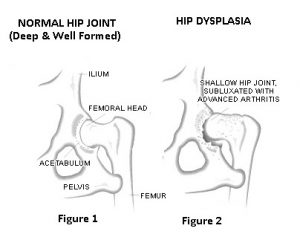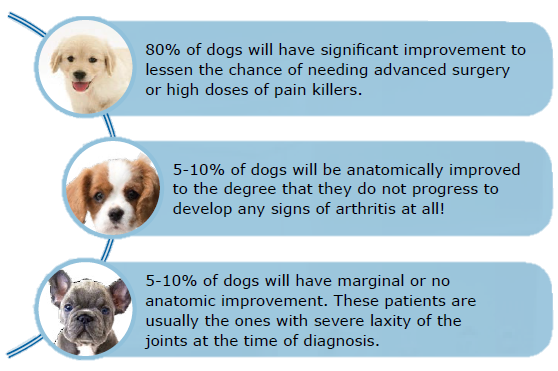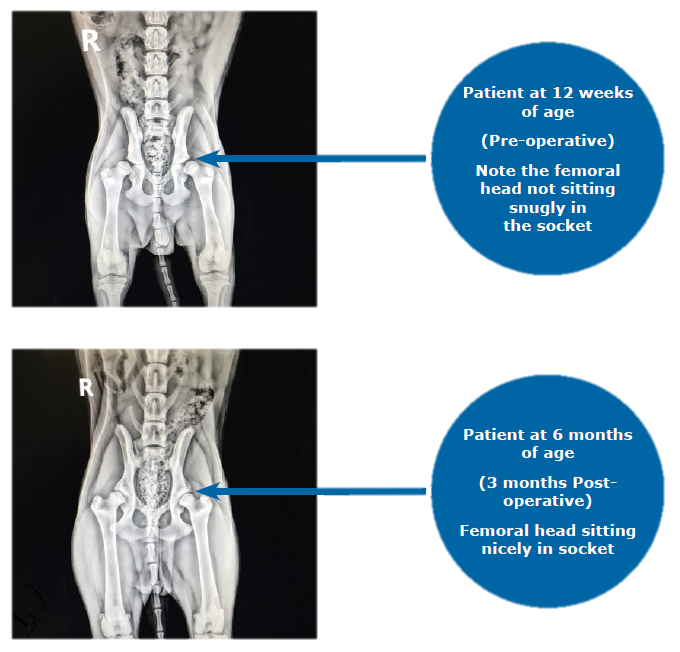A Surgical Procedure to Prevent the Progression of Hip Dysplasia in Young Dogs
What is hip dysplasia?
 The hip joint is a ‘ball and socket’ joint. Hip dysplasia is a disease of the hip joint which causes the joint to develop in an abnormal way, resulting in a shallow socket that the ball does not fit properly into. The shallow, loose joint is then prone to subluxate (partially dislocate). Eventually this condition leads to significant discomfort and lameness and progresses to what is often quite severe osteoarthritis. Risk breeds include Labradors, Golden Retrievers, German Shepherds, Rottweilers, Great Danes, Bernese Mountain Dogs, Saint Bernards, Newfoundlands, Neapolitan Mastiffs, British and French Bulldogs, Basset Hounds, pugs and King Charles Cavalier Spaniels. – Yes, even some small breeds!
The hip joint is a ‘ball and socket’ joint. Hip dysplasia is a disease of the hip joint which causes the joint to develop in an abnormal way, resulting in a shallow socket that the ball does not fit properly into. The shallow, loose joint is then prone to subluxate (partially dislocate). Eventually this condition leads to significant discomfort and lameness and progresses to what is often quite severe osteoarthritis. Risk breeds include Labradors, Golden Retrievers, German Shepherds, Rottweilers, Great Danes, Bernese Mountain Dogs, Saint Bernards, Newfoundlands, Neapolitan Mastiffs, British and French Bulldogs, Basset Hounds, pugs and King Charles Cavalier Spaniels. – Yes, even some small breeds!
The cause of hip dysplasia is multifactorial – mainly genetic, partly dietary, partly growth related and partly unknown. Purchasing a pup bred from parents that have good hip scores (this is determined by X-ray screening) may help to reduce the chance of getting this problem, but is in no way a guarantee. People are often disappointed when purchasing a pup from parents who have great hip scores, only to find out later their pup has severe hip dysplasia.
Hip dysplasia may be suspected (or in very severe cases diagnosed) by palpation for joint laxity (looseness), but requires X-rays of the hip joints under deep sedation or general anaesthesia to definitively determine if hip dysplasia exists. There are many options for treatment of hip dysplasia and these depend on the age of the pup at diagnosis, the severity, and whether or not osteoarthritis is present. ALL dogs diagnosed with hip dysplasia should be desexed due to the hereditary component of this disease.
What is Juvenile Pubic Symphysiodesis (JPS)?
Juvenile Pubic Symphysiodesis (JPS) is a relatively minor and cost effective early intervention surgical procedure that may significantly reduce the chance of needing far costlier surgical intervention (such as hip replacements), later on in life. It will also potentially reduce the development of osteoarthritis and the costly ongoing medical management associated lifelong with this condition.
This procedure uses an electroscalpel to create scarring in the growth plate of the floor of the pelvis. The effect of this is to halt bone development from this growth plate so that as the rest of the pelvis continues to grow, the cups of the hip joint externally rotate onto the ball of the hip joint to provide better coverage of the balls of the hip joint. The surgery causes minimal discomfort and your pup will need to have his/her activities slightly restricted for 10 days after surgery. Follow-up X-rays are taken two months post-operatively (at the same time as desexing) to assess the success of the surgery.
The best results are achieved if surgery is performed at 14-16 weeks of age, while the pelvis is still growing and developing. Between 16-20 weeks of age a good outcome is still possible, but significantly reduced compared to 14-16 weeks. Dogs greater than 20 weeks of age are unlikely to get a successful result. So, in order to have the option of this procedure for your dog, we need to diagnose him/her between 14-16 weeks of age. This is most important.

What is the Prognosis After Surgery?
Approximately 85-90% of dogs will have significantly improved anatomy, such that they are an excellent chance to not require more involved (and costly) specialist surgical revision at a later time in life such as hip replacement (approximately $8,000 – per side!). Some dogs will still develop hip arthritis but it is far more likely to occur later in life than it would have without JPS, and is also far more likely to be managed well with reduced medications than may otherwise be required.

The images below were taken at SAH by Dr Karin Davids:

For any Risk Breed We Advise the Following:
 1. At 14-16 weeks of age, X-ray the hips under sedation. The normal cost of sedation and X-rays would be $434 however to help at risk patients, we reduce this fee to only $195.
1. At 14-16 weeks of age, X-ray the hips under sedation. The normal cost of sedation and X-rays would be $434 however to help at risk patients, we reduce this fee to only $195.
2. If there is evidence of significant hip dysplasia (determined either by joint looseness or X-Ray changes), proceed to general anaesthesia and JPS surgery. The cost of JPS surgery will be $950 in total, inclusive of the X-rays. (Please note, we only recommend this procedure if significant changes are evident. If changes are minor or subtle and we do not feel there is a significant chance of improvement, we do not recommend proceeding with surgery. We will call you at the time of x-rays to discuss).
3. Two months after JPS surgery, follow-up X-rays can be taken at the same time as desexing surgery. The cost of this will be the usual desexing costs, plus follow up X-rays at a reduced fee of just $95.
 What if my hips are normal, am I able to be desexed at the same time at 14-16 weeks?
What if my hips are normal, am I able to be desexed at the same time at 14-16 weeks?
Absolutely! The beauty and flexibility of this process is that the choice is yours. You can choose to desex your dog at the same time, or later if you prefer your dog to grow out a little more. Feel free to discuss early diagnosis and corrective JPS further with any of our veterinarians if you have any more queries.
